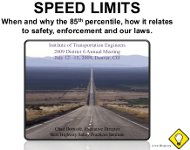Article from: www.thenewspaper.com/news/28/2843.asp
7/20/2009
Road Safety Group Argues for Return of Rational Speed Limits
Best Highway Safety Practices Institute presentation to engineering meeting argues for a return to speed limits based on engineering.
 In a speech last week before the Institute of Transportation Engineers (ITE), a road safety expert argued that speed limits should be based on engineering, not political considerations. Chad Dornsife, executive director of the Best Highway Safety Practices Institute made his case to an ITE annual meeting in Denver, Colorado.
In a speech last week before the Institute of Transportation Engineers (ITE), a road safety expert argued that speed limits should be based on engineering, not political considerations. Chad Dornsife, executive director of the Best Highway Safety Practices Institute made his case to an ITE annual meeting in Denver, Colorado.
"The solution is to properly engineer our roadways to facilitate the optimum flow of traffic, a prescription that would reduce our total vehicular carbon footprint and improve roadway safety," Dornsife said. "The future is in educating motorists to drive safely via safety campaigns that promote keep right except to pass, yielding, courtesy, and safety practices that are based in fact. Programs that create jobs, reduce our carbon footprint, pollution, and improve the safety and efficiency of our infrastructure."
Dornsife opened his presentation by explaining the federal role in setting consistent standards for road signs to prevent 80,000 local and state authorities from creating confusion as motorists travel across the country. The speed limit sign falls under the rules laid out in the federal Manual on Uniform Traffic Control Devices which specifies that the sign should reflect a limit determined by accepted principles of engineering. In a 1985 report, the Federal Highway Administration (FHWA) defined the most effective way to determine the number to print on the sign.
"Based on the best available evidence, the speed limit should be set at the speed driven by 85 to 90 percent of the free-moving vehicles rounded up to the next 5 MPH increment," FHWA's report, Speed Limit Synthesis, explained. "This method results in speed limits that are not only acceptable to a majority of the motorist, but also fall within the speed range where accident risk is lowest... No other factors need to be considered since they are reflected in the
drivers speed choice."
The federal agency's studies confirm that when speed limits are lowered or raised, the average speed of traffic does not change by a significant amount. Dornsife emphasized the point by citing the experience of Montana between 1995 and 1999.
"What happens when you have no daytime speed limits outside of the city limits, on every classification of roadway, paved or otherwise?" Dornsife asked. "Nothing. Motorists continued to drive at speeds they were comfortable with. Not one fatality was brought to our attention that was attributed to no daytime speed limits."
The fatal accident rate on Montana highways dropped to an all-time low when the state had no posted daytime speed limit. A speed monitoring site at Great Falls registered a change in average speed of just 1 MPH when the posted daytime limit was eliminated.
Dornsife argued that "politics, power and empires" changed federal policy in the mid-90s to dilute the influence of engineering in the setting of speed limits. New campaigns focused on issuing citations and imposing "zero tolerance" policies. As a result, most speed limits today are set unreasonably low and enforcement resources are misallocated to focus on drivers who are driving at speeds least likely to cause an accident.
Dornsife recommended that the situation could be corrected by undertaking regular surveys of driving speeds so that most roads could be re-posted at the measured 85th percentile speed. The exception would be work zones and school zones that should have 50th percentile speeds.
"Placing an invented number on a sign will not make you safer, but fact based laws that are uniformly applied, and making sure best safety practices are followed will," Dornsife concluded.
The BHSPI presentation is available in a 300k PDF file at the source link below.
Source: Speed Limits Presentation to ITE District 6 (Best Highway Safety Practices Institute, 7/15/2009)
Permanent Link for this item
Return to Front Page
 In a speech last week before the Institute of Transportation Engineers (ITE), a road safety expert argued that speed limits should be based on engineering, not political considerations. Chad Dornsife, executive director of the Best Highway Safety Practices Institute made his case to an ITE annual meeting in Denver, Colorado.
In a speech last week before the Institute of Transportation Engineers (ITE), a road safety expert argued that speed limits should be based on engineering, not political considerations. Chad Dornsife, executive director of the Best Highway Safety Practices Institute made his case to an ITE annual meeting in Denver, Colorado.